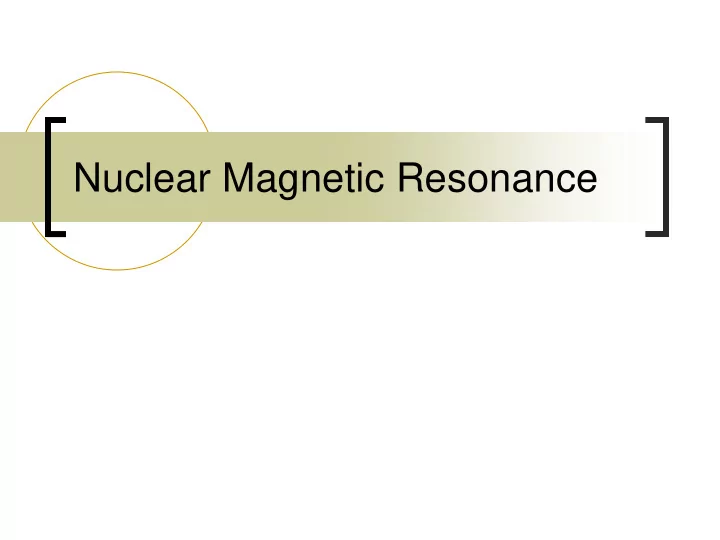

Nuclear Magnetic Resonance
NMR spectrum NMR spectrum of 1,1,2 trichloroethane Two different types of H Signals from both alkanes are split Integrals are in 2:1 ratio Molecular Spectroscopy CEM 484 2
Spin-spin coupling Spin-spin coupling responsible for multiple signals. For example, the single H atom experiences three different magnetic fields The external static field The induced field by valence electron motion (chemical shift) Local field due to protons on adjacent carbon Add a term to the Hamiltonian. Ĥ = Ĥ 1 nz + Ĥ 2 nz + Ĥ (1-2) ss Ĥ 1 and Ĥ 2 result from zeeman effect, much greater than ss. Treat ss as a perturbation Molecular Spectroscopy CEM 484 3
Wavefunction Distinguishable protons. Four different eigenstates for the nuclear Zeeman portion of Hamiltonian. Ψ 1 = a (1) a (2) Ψ 2 = a (1) b (2) Ψ 3 = b (1) a (2) Ψ 4 = b (1) b (2) Operate on the respective wavefunction with the Hamiltonian to determine state energies. Molecular Spectroscopy CEM 484 4
Energies (1) Molecular Spectroscopy CEM 484 5
Energies (2) Molecular Spectroscopy CEM 484 6
Energies (3) Molecular Spectroscopy CEM 484 7
Spin-spin coupling Spin-spin hamiltonian Ĥ ss = hJ 12 /hbar 2 *I 1 *I 2 J 12 spin coupling constant Wavefunctions are not eigenstates of Ĥ ss so they are treated using perturbation theory Molecular Spectroscopy CEM 484 8
Spin-spin coupling (1) Molecular Spectroscopy CEM 484 9
Spin-spin coupling (2) Molecular Spectroscopy CEM 484 10
Spin-spin coupling (3) Molecular Spectroscopy CEM 484 11
Spin-spin coupling Energy level diagram with spin-spin coupling. Only four different transitions are allowed. Molecular Spectroscopy CEM 484 12
Indistinguishable protons Why do indistinguishable protons not show a splitting? Consider dichloromethane. Need symmetric and antisymmetric wavefunctions Molecular Spectroscopy CEM 484 13
Indistinguishable protons (1) Apply same Hamiltonian to the system Molecular Spectroscopy CEM 484 14
Indistinguishable protons (2) Apply same Hamiltonian to the system Molecular Spectroscopy CEM 484 15
Indistinguishable protons (3) Spin-spin coupling Molecular Spectroscopy CEM 484 16
Indistinguishable protons (4) Spin-spin coupling Molecular Spectroscopy CEM 484 17
Recommend
More recommend